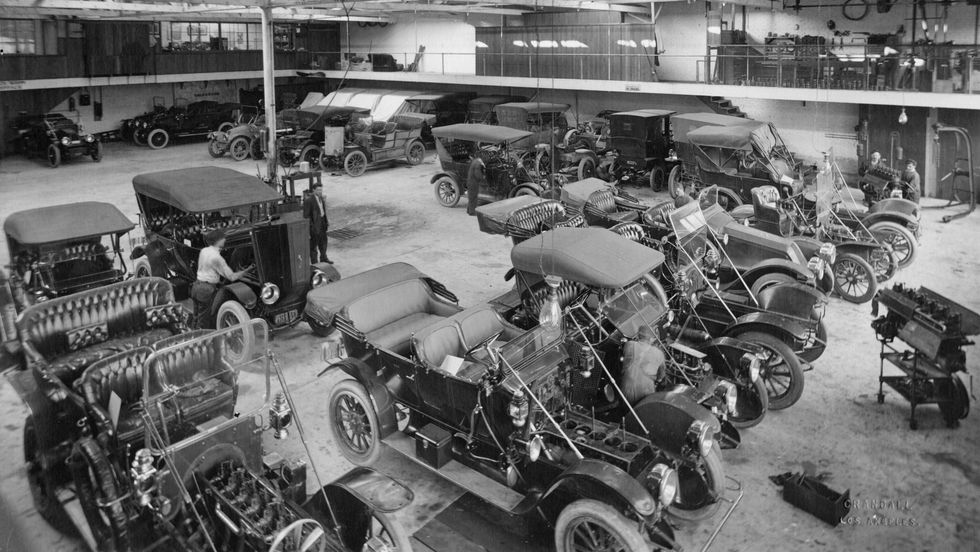Los Angeles is named a world capital of automotive tradition, a germinating level for tendencies set amid ubiquitous superhighways and their crushing smog and visitors. However how and why did L.A. change into a metropolis of automobiles? A deeply researched and richly illustrated new e-book, Driving Power: Cars and the New American Metropolis 1900–1930 (Angel Metropolis Press, $50) by Darryl Holter and Stephen Gee seeks to reply these questions.
Holter posits {that a} mixture of key elements catalyzed the why of L.A.’s vehicular obsession. In contrast to New York or Chicago, the brunt of L.A.’s colonization by Europeans, and industrialization, started late within the nineteenth century, contemporaneous with the car’s growth. “Each got here of age on the identical time, they form of grew up collectively and their relationship was intertwined,” Holter explains.
The sunny local weather allowed automobiles for use year-round, a boon and a novel market attribute within the automotive’s early years earlier than roofs or paved roads. And, not like in New York or Chicago, the place trains traverse town in addition to commute to the periphery, the mounted rail system in L.A. was arrange primarily to maneuver individuals forwards and backwards from work within the middle to residences within the suburbs. The automotive provided freedom for intracity journey.
The mountainous topography of Los Angeles, and the residential and industrial growth of it, additionally lent itself to the automotive and vice versa. “The car allowed individuals to go farther away from the middle, increased into the hills, nearer to the desert, nearer to the ocean,” Holter explains. “And that, in fact, meant that actual property might be developed there.”
The nascent movie business was ready to make use of vehicles to scout and shoot (and star) within the diverse locales—city, suburban, rural, mountainous, seaside, riverside, desert, ranch—inside straightforward attain of town. And the arrival of the automotive meant that filmmakers and actors now not wanted to hold their gear or put on their costumes on the practice or streetcars, a liberating shift in manufacturing scale. “Hollywood made the automotive, and the automotive made Hollywood,” Holter says.
The Native Seller Was Essential
However the core focus of the e-book is on how L.A. turned the epicenter of the automotive market. Holter attributes that to at least one core notion. “It was these actually native entrepreneurs, bankers and automotive sellers, native danger takers, who supplied the vital hyperlink between the carmakers and patrons,” he says. “It was the sellers who discovered methods, by means of trial and error, to place individuals behind the wheel, and ultimately satisfied them that the automotive was a necessity and never only a luxurious.”
These improvements included many nonetheless in apply at present. Major amongst these had been the unbiased automotive dealership franchise, the used-car market, and dealer-sponsored service facilities. However maybe essentially the most profound was the thought of laborious items financing: making a big buy like this on credit score. Previous to the automotive, the notion of an accessible and more and more mandatory class of business good—one inside attain of the frequent individual, however which could not readily be bought outright—did not exist.
“Neither the factories nor the banks or the finance corporations provided retail credit score in these early years. So the sellers, as a result of they needed to promote automobiles on their very own, began to experiment with paying on operating credit score by accepting down funds and promissory notes,” Holter says.
Much more intriguing is the confluence Holter uncovers between these retail institutions and the early broadcast business. L.A. sellers had been among the many first house owners of native radio stations corresponding to KFI and KNX. “These stations had been launched primarily as a method of promoting automobiles,” Holter says. The motivation was monetary, but additionally temperamental. “These sellers turned rich so shortly that they had been looking for the following groundbreaking expertise, in search of the following funding,” Holter says. “That is the kind of entrepreneurs they had been.”
Holter believes that the e-book has profound modern relevance, as customers and automakers debate the validity of the franchise seller system. “I believe that a number of the identical elements that prompted direct gross sales approaches to fail greater than a century in the past should forestall excessive quantity producers from actually with the ability to go completely direct,” he says.
In accordance with Holter, these embrace human-to-human contact in gross sales and negotiations, in addition to protocols for supply and repairs. “Issues like that,” he says, “I do not suppose are dealt with properly by the web.” (We would add the unfairly privileged pricing and allocations, and different misleading practices, that OEMs have granted to shops they personal within the distant and up to date previous, one of many causes for the institution of the seller system within the first place.)
Holter additionally thinks the story of the automotive’s emergence, and subsequent international domination, speaks to our shifting modern setting, and the potential for unanticipated penalties of latest innovations—like useful AI. “It is a reminder of how we’ve got modified society and the way laborious it could be for individuals to surrender these adjustments,” Holter says. “However it’s additionally a reminder that when you create the correct expertise on the proper value, the influence might be monumental.”
Contributing Editor
Brett Berk (he/him) is a former preschool trainer and early childhood middle director who spent a decade as a youth and household researcher and now covers the matters of youngsters and the auto business for publications together with CNN, the New York Instances, Fashionable Mechanics and extra. He has printed a parenting e-book, The Homosexual Uncle’s Information to Parenting, and since 2008 has pushed and reviewed 1000’s of automobiles for Automobile and Driver and Highway & Observe, the place he’s contributing editor. He has additionally written for Architectural Digest, Billboard, ELLE Decor, Esquire, GQ, Journey + Leisure and Self-importance Honest.


